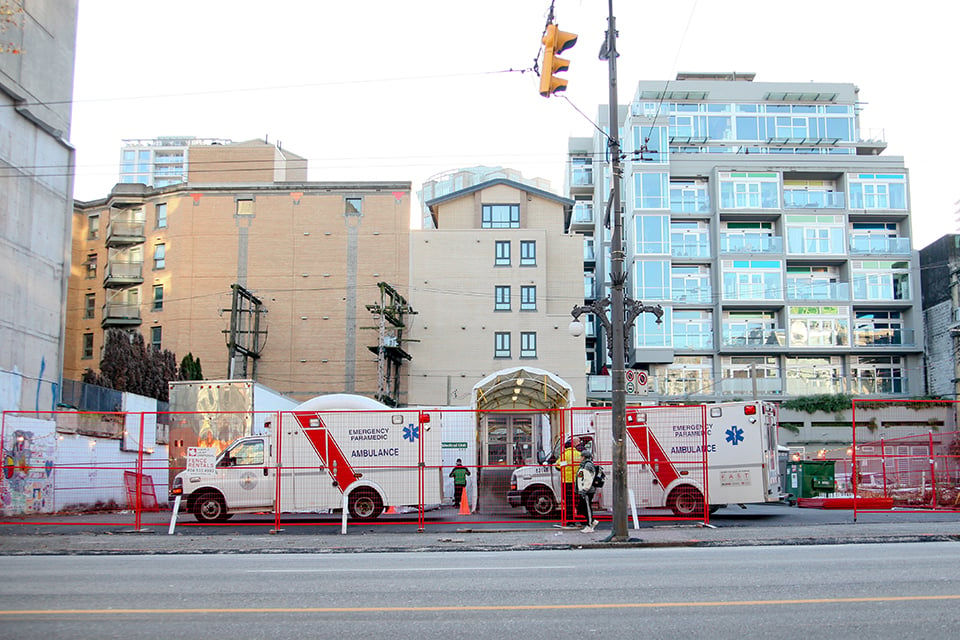New protocol at St. Paul’s hospital following Surrey father’s ‘suicide’
Without change, ‘Spencer won’t be the last’: brother
A new protocol for dealing with patients who
are admitted to hospital with concurrent mental health and physical
conditions is now “part of the mix” at St. Paul’s Hospital, following
the death nearly three years ago of a Surrey father at the Vancouver
facility.
Spencer Walden spent his final days at St. Paul’s in February 2016, before falling to his death – in what has been ruled a suicide – from one of its seventh-storey windows.
READ MORE: Surrey man’s death prompts call for change
READ MORE: Answers sought after Surrey man’s in-care death
Providence Health spokesman Shaf Hussein confirmed that steps have been taken as a result of the “very sad and tragic story,” in an effort to better care for dual-diagnosis patients.
The possibility “of moving higher-risk complex patients to mental health units with a medical nurse brought in to oversee one-to-one medical care” was a specific addition to protocols, Hussein told Peace Arch News by email Dec. 13.
It was added “about a year ago.”
As well, within planning for a new hospital, “we indeed have included specialized ‘dual-diagnosis’ beds as part of the care models,” Hussein said.
Spencer, 32, died on Feb. 18, 2016, three days after being brought to St. Paul’s with “an altered level of consciousness.” In the weeks prior, he had been undergoing treatment at Peace Arch Hospital for his deteriorating mental state, but had left that facility on Feb. 14 against medical advice. He was found the next morning by Vancouver police.
At St. Paul’s, diagnosed with a liver injury, Spencer was placed in a medical ward. At one point, he was physically restrained due to signs of paranoia, including hearing voices, but – despite appeals from his family for more secure care – he remained on a medical ward.
On the day he died, according to a coroner’s report released to PAN Dec. 10, Spencer – shortly after being asked if he was having suicidal thoughts and responding, “I’m good” – smashed a window with an oxygen tank, sat on the ledge and leaned out backwards.
His case was reviewed after his family challenged the ruling of suicide.
In her report, coroner Claire Thompson upheld the classification, noting it includes deaths in people whose cognition may be impaired by acute psychosis, intoxication or impulsive acts.
Following the report’s release, Spencer’s brother Brodie Walden told PAN he still has “trouble believing” Spencer intended to take his own life.
He said the report is “fairly vague” on details of what happened in the minutes before his brother died, including if any other patients were in the room at the time.
“For all we know, he was seeing demons in the room,” Brodie said. “When you’re thoroughly convinced (of) something like that, you can’t predict behaviour.
“Some more facts may be required to actually discern what went on. That’s going to leave a lot of vacancy in our thoughts about what actually happened.”
Thompson noted that beds dedicated to treating dual-diagnosis patients are “very limited” in B.C.
Fraser Health spokesperson Tasleem Juma couldn’t comment on Spencer’s case specifically, but confirmed there are no beds with that precise definition in the region – not because the services don’t exist, but “because the way we deliver the service is very different.”
At the same time, she said it’s unclear exactly what the coroner meant by “dual-diagnosis” beds.
“Many of our patients have multiple medical issues that need to be dealt with simultaneously,” Juma said Tuesday.
“I can’t really comment on this definition… It’s not ‘this patient goes into this bed.’ It’s ‘the patient comes in and needs the service and we bring the service to them.’
“We wrap the services around the individual.”
In the case of a patient with a risk of leaving or potentially harming themselves or someone else, “we have the ability, for example, to have one-to-one companionship for that person,” Juma said.
“We would have somebody stay with them all the time, even if they were not in the psychiatric unit.”
Brodie said it’s clear to his family that resources are lacking to treat people who are struggling in ways similar to his younger brother.
Spencer had grappled with his mental health since he was a teenager, but with treatment and family support, was high-functioning and productive, according to his family.
In “troubling times” that occurred every few years – typically rooted in Spencer tapering off his medications – Spencer’s wife, mom and siblings “were there to always help him and make sure he made it through,” family members told PAN in a September 2016 interview.
Brodie said following the release of the coroner’s report that during those difficult times, Spencer would gravitate to the Downtown Eastside, “to people that were like him.”
“If there’s not enough resources to treat people like that, there should be,” he said.
The challenge now, he said, is how to effect change.
Steps so far are “in the right direction,” Brodie said.
But he’s at somewhat of a loss as to where to go from here.
“Some of us are willing to fight, myself included. But at what cost? And what change are we going to get out of this?” he said.
“Until somebody actually wants to listen, it makes it very difficult.”
Brodie is certain of one thing: without change, Spencer “won’t be the last.”
Hussein could not comment on specific bed numbers planned for the new hospital, but said the learning at St. Paul’s is continuous, “from our experiences, from our patient and family partners, from research and from trends in patient needs… and we aim to improve care, fill in gaps in the best way possible from these continuous learnings.”
As further example, he cited the opening four years ago of St. Paul’s Acute Behavioural Stabilization Unit (ABSU), done “in response to growing concerns for dual-diagnosis (mental health/substance users) patients,” as well as the opening last summer of the HUB and Transitional Care Centre, which also targets those struggling with mental health and addictions.
Spencer Walden spent his final days at St. Paul’s in February 2016, before falling to his death – in what has been ruled a suicide – from one of its seventh-storey windows.
READ MORE: Surrey man’s death prompts call for change
READ MORE: Answers sought after Surrey man’s in-care death
Providence Health spokesman Shaf Hussein confirmed that steps have been taken as a result of the “very sad and tragic story,” in an effort to better care for dual-diagnosis patients.
The possibility “of moving higher-risk complex patients to mental health units with a medical nurse brought in to oversee one-to-one medical care” was a specific addition to protocols, Hussein told Peace Arch News by email Dec. 13.
It was added “about a year ago.”
As well, within planning for a new hospital, “we indeed have included specialized ‘dual-diagnosis’ beds as part of the care models,” Hussein said.
Spencer, 32, died on Feb. 18, 2016, three days after being brought to St. Paul’s with “an altered level of consciousness.” In the weeks prior, he had been undergoing treatment at Peace Arch Hospital for his deteriorating mental state, but had left that facility on Feb. 14 against medical advice. He was found the next morning by Vancouver police.
At St. Paul’s, diagnosed with a liver injury, Spencer was placed in a medical ward. At one point, he was physically restrained due to signs of paranoia, including hearing voices, but – despite appeals from his family for more secure care – he remained on a medical ward.
On the day he died, according to a coroner’s report released to PAN Dec. 10, Spencer – shortly after being asked if he was having suicidal thoughts and responding, “I’m good” – smashed a window with an oxygen tank, sat on the ledge and leaned out backwards.
His case was reviewed after his family challenged the ruling of suicide.
In her report, coroner Claire Thompson upheld the classification, noting it includes deaths in people whose cognition may be impaired by acute psychosis, intoxication or impulsive acts.
Following the report’s release, Spencer’s brother Brodie Walden told PAN he still has “trouble believing” Spencer intended to take his own life.
He said the report is “fairly vague” on details of what happened in the minutes before his brother died, including if any other patients were in the room at the time.
“For all we know, he was seeing demons in the room,” Brodie said. “When you’re thoroughly convinced (of) something like that, you can’t predict behaviour.
“Some more facts may be required to actually discern what went on. That’s going to leave a lot of vacancy in our thoughts about what actually happened.”
Thompson noted that beds dedicated to treating dual-diagnosis patients are “very limited” in B.C.
Fraser Health spokesperson Tasleem Juma couldn’t comment on Spencer’s case specifically, but confirmed there are no beds with that precise definition in the region – not because the services don’t exist, but “because the way we deliver the service is very different.”
At the same time, she said it’s unclear exactly what the coroner meant by “dual-diagnosis” beds.
“Many of our patients have multiple medical issues that need to be dealt with simultaneously,” Juma said Tuesday.
“I can’t really comment on this definition… It’s not ‘this patient goes into this bed.’ It’s ‘the patient comes in and needs the service and we bring the service to them.’
“We wrap the services around the individual.”
In the case of a patient with a risk of leaving or potentially harming themselves or someone else, “we have the ability, for example, to have one-to-one companionship for that person,” Juma said.
“We would have somebody stay with them all the time, even if they were not in the psychiatric unit.”
Brodie said it’s clear to his family that resources are lacking to treat people who are struggling in ways similar to his younger brother.
Spencer had grappled with his mental health since he was a teenager, but with treatment and family support, was high-functioning and productive, according to his family.
In “troubling times” that occurred every few years – typically rooted in Spencer tapering off his medications – Spencer’s wife, mom and siblings “were there to always help him and make sure he made it through,” family members told PAN in a September 2016 interview.
Brodie said following the release of the coroner’s report that during those difficult times, Spencer would gravitate to the Downtown Eastside, “to people that were like him.”
“If there’s not enough resources to treat people like that, there should be,” he said.
The challenge now, he said, is how to effect change.
Steps so far are “in the right direction,” Brodie said.
But he’s at somewhat of a loss as to where to go from here.
“Some of us are willing to fight, myself included. But at what cost? And what change are we going to get out of this?” he said.
“Until somebody actually wants to listen, it makes it very difficult.”
Brodie is certain of one thing: without change, Spencer “won’t be the last.”
Hussein could not comment on specific bed numbers planned for the new hospital, but said the learning at St. Paul’s is continuous, “from our experiences, from our patient and family partners, from research and from trends in patient needs… and we aim to improve care, fill in gaps in the best way possible from these continuous learnings.”
As further example, he cited the opening four years ago of St. Paul’s Acute Behavioural Stabilization Unit (ABSU), done “in response to growing concerns for dual-diagnosis (mental health/substance users) patients,” as well as the opening last summer of the HUB and Transitional Care Centre, which also targets those struggling with mental health and addictions.
 Spencer Walden with his daughter. (Contributed photo)
Spencer Walden with his daughter. (Contributed photo)























